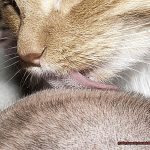Do cats get blackheads? It’s a question many pet owners have asked. The answer is yes.
Blackheads are a common skin disorder in humans, but cats can suffer from them too. In this blog post, we’ll explore what blackheads are and how they affect cats.
We’ll also look at the causes of blackheads in cats and offer tips for preventing and treating them. Blackheads appear as tiny bumps when a hair follicle becomes clogged with dirt and oil.
They appear dark due to the oxidation of oils in the follicle. You can find them on any part of the body, but they’re most common on the face, neck, chest, and back – especially around the chin or muzzle area in cats due to their grooming habits.
Poor grooming habits, allergies or sensitivities to certain foods or environmental irritants like dust mites or pollen, hormonal changes during puberty or breastfeeding, underlying medical disorders such as diabetes or thyroid disease, and stress or anxiety can all lead to blackhead formation in cats. Fortunately, there are ways to help prevent and treat blackheads in your cat.
Regular brushing will remove excess dirt and oils from your cat’s fur which reduces the chance of blackhead formation. Avoiding potential allergens like dust mites or pollen can also minimize inflammation that could lead to blackhead formation.
By knowing what causes blackheads in cats and taking proactive steps toward prevention and treatment you can help keep your feline friend looking their best.
Causes of Feline Acne
Feline acne is a common skin condition that can affect cats of all ages, genders, and breeds.
Characterized by blackheads on the chin that can become inflamed and develop into pimples or cysts, feline acne can be a cause for concern. Although the exact cause of this condition is unknown, there are several factors that may contribute to its development.
These include hormonal imbalances, bacterial infections, poor grooming habits, allergic reactions, and even genetics. If you suspect your cat has feline acne, it’s important to consult with a veterinarian to ensure the right diagnosis and treatment strategy.
Symptoms of Feline Acne
Feline acne is an all too common skin ailment that can affect cats of any age, sex, or breed.
Characterized by the formation of small black or brown bumps, known as comedones or blackheads, on the chin, lips, and throat region of the cat’s face, it can range from mild to severe in its symptoms. While mild cases may not cause pain or show any clinical signs of illness, more serious forms can lead to redness and swelling in the affected area as well as secondary infections if left untreated.
For proper diagnosis and treatment of feline acne, pet owners should look out for comedones and other signs of inflammation such as scabs, crusts, or papules. Seeking prompt veterinary attention is essential for optimal management and outcome of the disease.
Additionally, changes in diet and grooming habits may be needed to prevent recurrence.
Is Cat Acne Contagious to Humans?
Cats are beloved and loyal companions, but unfortunately, they can be prone to skin conditions such as feline acne.
Although this condition is not contagious to humans, it’s still important to take the necessary precautions when dealing with cats with acne. If your cat has open sores, scabs, or redness on their face, it’s crucial to avoid touching the affected areas directly.
After handling your pet, make sure to wash your hands thoroughly with soap and water – this double-shield will help protect you from any potential infections. It is also essential to see a veterinarian for diagnosis and treatment as soon as possible.
And whatever you do, don’t try any home remedies without expert guidance – tea tree oil or hydrogen peroxide may be too harsh on your pet’s skin or cause allergic reactions.
Treatment Options for Feline Acne
Feline acne is a common skin condition that can cause discomfort and distress for our beloved cats.
Fortunately, there are a number of treatment options available to help manage this illness. From gentle cleansing and grooming to topical creams and oral medications, we can protect our cats from pesky invaders.
For mild cases, simple sanitizing and grooming products can be used, such as a damp washcloth or cotton ball to wipe away any dirt or oil that may be clogging the pores. For more severe cases, topical creams like benzoyl peroxide or clindamycin gel can reduce inflammation and control the growth of bacteria and yeast.
In some cases, oral medications may be prescribed by a veterinarian to alleviate symptoms of feline acne. It’s important to note that over-the-counter acne treatments designed for humans should never be used on cats as they can be toxic and cause serious harm.
Additionally, it is also important to address any underlying conditions that could be contributing to the acne, such as dietary changes or a change in grooming habits.
Hygiene Practices to Reduce Blackheads in Cats
There are several hygiene practices you can use to reduce their appearance and keep your furry friend healthy. Start by making sure your cat’s fur is regularly groomed and brushed.
This will help to remove any dirt, oil, or dead skin that could be clogging the pores. Additionally, make sure to replace their plastic food and water bowls with stainless steel, ceramic, or glass bowls that are easier to clean.
After they eat, use an antibacterial wipe or solution to clean their chin. This will help eliminate any trapped food particles or oily residue that contribute to blackheads.
Just be sure to choose a product that is safe for cats and avoid getting it in their eyes or nose. If you find that your cat is consistently developing blackheads despite regular cleaning, it may be worth consulting with your veterinarian.
They can help determine if there are any underlying medical conditions causing the issue and recommend appropriate treatment options.
Environmental Factors that can Contribute to Feline Acne
Feline acne is a common skin disorder that can cause cats of all ages and breeds a lot of discomfort.
While the exact cause of feline acne is unknown, there are several environmental factors that can trigger the condition. To prevent your cat from developing this irritating skin condition, it is important to be aware of the potential environmental triggers and take steps to reduce their risk.
One of the main environmental factors that contribute to feline acne is a dirty environment. Bacteria can thrive in contaminated environments, leading to skin irritation and blackheads around the chin area.
To keep your cat’s environment clean and reduce their risk of developing acne, make sure you’re regularly cleaning their food bowls and litter boxes. Additionally, consider switching out traditional bedding products for more comfortable fabrics such as cotton or fleece.
Another environmental factor that can contribute to feline acne is stress. Cats are sensitive animals who can easily become stressed by changes in their environment or routine.
Stress weakens the immune system, making it easier for bacteria to invade the skin and cause acne. To reduce your cat’s risk of developing feline acne due to stress, try to maintain a stable environment for them and avoid any drastic changes in their daily routine.
Finally, certain grooming products and fabrics can also contribute to feline acne. Products that contain fragrances or harsh chemicals can irritate the skin, while fabrics such as wool or synthetic materials may be abrasive and cause skin irritation.
When choosing grooming products for your cat, make sure they are gentle on their skin – no harsh chemicals or fragrances.
Stress and Diet as Contributing Factors in Feline Acne
Feline acne is a common problem that can cause cats of all ages distress.
Fortunately, it doesn’t have to be permanent; stress and diet can both contribute to feline acne, so if your cat is suffering from this condition, it’s essential to consider these two factors before seeking medical attention. Stress can be caused by environmental or lifestyle changes, and if your cat is exhibiting signs such as excessive grooming, hiding or aggression, it’s important to identify and address the source of the stress in order to prevent further acne breakouts.
In addition, a poor diet can also lead to feline acne. A diet lacking essential nutrients and fatty acids can cause dry skin and weaken your cat’s immune system, making it easier for bacteria to thrive and cause acne.
To promote healthy skin and overall well-being, provide your cat with a well-balanced and nutritious diet. If you suspect that your cat’s acne is caused by stress or diet, consulting your veterinarian for proper diagnosis and treatment is key.
They may recommend dietary changes, stress management techniques or topical medications to soothe and heal your cat’s skin.
How to Tell if Your Cat has Blackheads
Feline acne is a common skin condition that affects cats of all ages, genders, and breeds. It is characterized by blackheads on the chin that can become inflamed and develop into pimples or cysts.
The exact cause of feline acne is uncertain, but it is thought to be linked to overproduction of oil from the skin’s sebaceous glands, a buildup of dead skin cells, bacterial infections, and hormonal imbalances. Other environmental and lifestyle factors such as poor diet and dirty food or water bowls can also contribute to its development.
To determine if your cat has blackheads, you should first inspect their chin area. Blackheads in cats usually appear as small raised bumps that may be black or dark brown in color.
These bumps can be difficult to spot in cats with darker fur, so you may need to run your fingers over your cat’s chin to feel for them. If you feel bumps on your cat’s chin, it’s essential not to squeeze them as doing so will cause pain, inflammation, and even infection.
Conclusion
Can cats get blackheads? The answer is yes. Just like humans, cats can suffer from this condition.
Poor grooming, allergies, hormonal changes, underlying medical conditions, and stress can all contribute to the formation of blackheads in cats. To reduce the likelihood of blackheads appearing, regular brushing and avoiding potential allergens is essential.
If you suspect your cat has feline acne – don’t hesitate to consult with a veterinarian for diagnosis and treatment.







